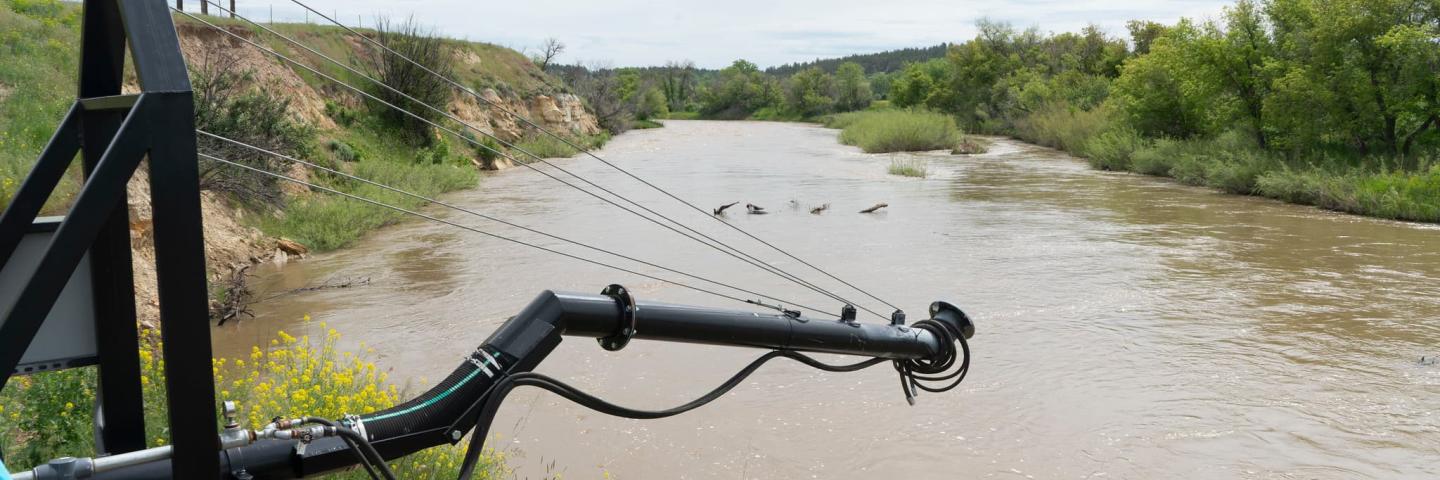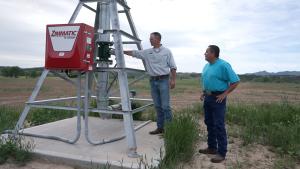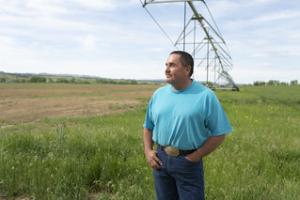A Better Place

Jimmy Robinson continues to work with NRCS into the future to ensure irrigation water efficiency and to diagnose his land’s needs and find tools to address them.
Watch their story on YouTube: Conservation for the Future: Tackling Challenges on Tribal Land, Northern Cheyenne Reservation, MT
“I’m more of a nature guy,” Jimmy Robinson explains as he walks across his ranch near the banks of the Tongue River. The silhouettes of mountains line the horizon here on this patch of land that runs in his family. Today, Robinson is having to adapt in order to find ways to continue sustainable operations here.
“I’m a rancher, always have been. My grandparents and parents grew up as ranchers. I went into farming because hay was so hard to get, and we ran into droughts, and it got so far and wide and expensive.”
Many producers in Montana and around the northern Great Plains will find this struggle familiar. Widespread, intense, and persistent drought along with rising prices mean that Robinson is far from alone in having to change his operations.
“With this drought that came on,” Robinson says before his voice trails off momentarily. “In my years, I’ve never seen a wider spread of weeds.”
Robinson knew several things he wanted to do to improve his property’s infrastructure, soil health, and grazing practices. He knew where he needed additional stock tanks, cross-fencing, and irrigation infrastructure. While these represent a significant investment that would necessitate careful planning and assistance for any farmer or rancher, Robinson faced additional hurdles.
How he overcame them shows just what’s possible here on the Tongue River, and across the country.
An Isolated Place

Robinson’s ranch and farmland sits on the far eastern end of the Northern Cheyenne Reservation. Like many tribal reservations, its geographic isolation has led to commercial isolation.
Evan Van Order, Tribal Conservationist with the local office of the USDA Natural Resources Conservation Service (NRCS), explains that some major challenges historically underserved producers like Robinson encounter include, “distance to market and distance to resources available, like materials and contractors to be able to install some of the infrastructure of these conservation practices.”
“Especially right now, it seems like it’s real hard to get a well driller and contractors out for stock water systems.”
When Robinson realized that he needed help to be able to successfully improve upon his land, he reached out to Van Order and the NRCS. Since 2019, they’ve built a relationship that has enabled Robinson to get the technical and financial assistance he needs and has left Van Order impressed with the producer’s passion.
“What I really observed and have appreciated is that Jimmy is really driven to make improvements to his operation,” Van Order says. “We’ve done some good conservation projects here, and I’m excited to see the rest of his plan unfold as the rest of these practices are implemented.”
Finding Help
By working with Van Order, Robinson was able to find solutions when doors were seemingly closed to him.
For example, typical NRCS requirements state that for a producer to be eligible for irrigation improvements, they need to have used existing irrigation systems on the property for at least two of the most recent five years. That reads as though it would pose a problem, given the infrastructure situation on the reservation.
“There’s a lot of these fields within the reservation boundaries that had historically been irrigated, but the infrastructure has either not been maintained or has disappeared in some way because of the movement of the river,” Van Order explains. “So. there’s been opportunities for some of this historically irrigated ground to be improved.”
Robinson’s land had not been irrigated within the five-year limit, but Van Order was able to show the NRCS that the land had been irrigated in the past and still had existing infrastructure. Robinson was given an Irrigation History Waiver, which allowed him access to support from the NRCS to bring water to his parched land.
Through the Environmental Quality Incentives Program (EQIP) from NRCS, Robinson installed the pivot, pump, and pipeline in 2021. The program helped provide him valuable financial assistance, but NRCS help also encompasses technical guidance, helping Robinson determine the best system for his property and how to run that system. They continue to work with him to determine and implement the best irrigation water management practices for his land.
Robinson’s alfalfa crop is watered by the center-pivot, which is in turn fed by a pump reaching into the Tongue River. Robinson can control the pivot and pump all from his smart phone, so he can respond to his crop’s needs without being in the field.
When Robinson first started producing his own hay, he crucially took up another water- and soil-saving measure: planting a cover crop. This helps him reduce moisture loss and control the nutrient exchange in the soil in order to ensure the soil is a healthy setting for his bread-and-butter crops while helping suppress weeds.
Changes for the Future

“This here is the pump that does pump the water into the pivot,” says Robinson, standing next to a large black unit with a steel arm extending over the Tongue River. “NRCS has helped me with the pivot project here and, without this, I don’t think I could have continued in operation with my cows.”
Robinson has planted alfalfa so that he won’t have to buy hay, which gives him several benefits, in terms of agriculture and history.
“I chose alfalfa because it was something that my family has always grown,” says Robinson. He also values its high protein content and the fact that it’s a perennial. “It grows faster than the grass will. For grass, you’ll only get maybe two cuttings, where alfalfa, you’ll get your third cutting. You could get a fourth cutting, but nature has to be very good to you.”
Robinson’s changes go beyond a single alfalfa field. Most of his cattle forage on his expansive rangeland, implementing rotational grazing to reduce the stress on the existing forage. This helps conserve resources and combat the spread of noxious weeds. A stronger ratio of forage to weeds means—among other things—that water is being used more efficiently, since it isn’t being siphoned by invasive plants.
When your livelihood exists at the mercy of mother nature, you pay close attention to what’s going on in your climate and environment. That’s another key reason Robinson is making changes to his operation.
“A challenge in these parts here is water,” Robinson says. “There’s not enough water as in streams or reservoirs. Reservoirs are a thing of the past. There’s not enough runoff anymore.”
Robinson says ranchers need to respond by focusing on the health of their pastures. Van Order is working with Robinson to identify noxious weeds that are infiltrating his pastures and finding targeted ways to eradicate them.
“Our grazing needs to be better practices,” Robinson says. “If you overgraze, you bring up more weeds. You defeat the grass. That is probably one of the biggest challenges.”
Robinson will continue to work with NRCS into the future to ensure irrigation water efficiency and to diagnose his land’s needs and find tools to address them. They plan to install soil moisture sensors to gauge water application efficiency and retrofit an existing stockwater tank to use a solar-powered pump rather than a windmill. All this will happen concurrently with improvements to the rotational grazing infrastructure.
“With our challenging world right now, with our weather and weeds and the way our weather is going, NRCS is a very helpful tool,” Robinson says. “It could take us to a better level.”
As Robinson demonstrates the phone app he uses to remotely control the pivot, it’s easy to see that better level he talks about is possible. In many ways, Jimmy Robinson is well on his way there.
More Information
High resolution photos of this project.
To learn more about NRCS conservation assistance, please visit your Local Service Center or nrcs.usda.gov/montana, where you can also find contact information for the office in your county.

